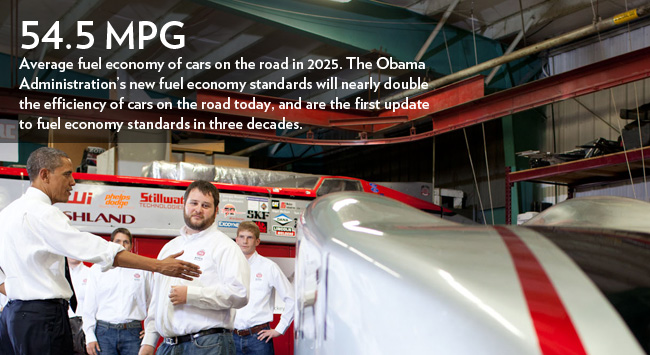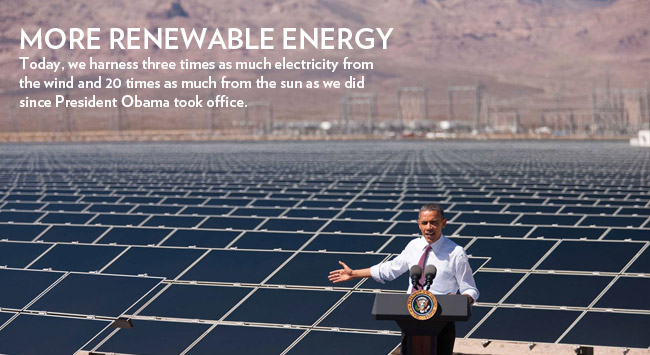Energy and Environment Latest News
West Wing Week: 04/24/15 or, "The Savage Splendor of a Swamp"
Posted by on April 24, 2015 at 3:38 PM EDTThis week, the President hosted the Italian Prime Minister, three different sports teams, and a bipartisan group of members of Congress. He also visited the Everglades in balmy Florida to celebrate Earth Day with Bill Nye. That's April 17th to April 23rd or, "The Savage Splendor of a Swamp."
The Land and Water Conservation Fund: Congress Must Act to Fulfill Commitment to Communities
Posted by on April 24, 2015 at 3:36 PM EDTFor 50 years, the Land and Water Conservation Fund has been one of the most popular and effective tools used to protect and restore special places like the Everglades. By reinvesting revenues from offshore oil and gas development, the Fund has made it easier for people to enjoy to the outdoors for hunting, fishing, and other recreation and protected iconic places like National Parks and Civil War battlefields. And, as Secretaries Vilsack and Jewell noted in an Earth Day op-ed, “the law has been regarded as one of the most successful programs for recreation and conservation investments in our history.”
But if Congress doesn’t act, the Land and Water Conservation Fund will expire in September.
That’s why, when President Obama visited Everglades National Park on Earth Day, he called on Congress to reauthorize and fully fund the Land and Water Conservation Fund. The Fund has supported our work to restore the natural water flow of the Everglades, and other important restoration and conservation efforts across the country.
Just this week, the Department of the Interior announced that investments from the Fund would be used to enhance parks in eight cities’ underserved neighborhoods. Three million dollars in investments will be used to renovate damaged storm water systems, protect wildlife habitats, and provide outdoor education programs. These types of investments are critical for getting more young people connected to the outdoors.
And today, the U.S. Department of Agriculture announced that the Fund has been used to protect another treasured place: the historic Campbell property within the George Washington-Jefferson National Forest along the Appalachian National Scenic Trail. With support from the National Park Service, the Conservation Fund purchased the 317-acre property last year and conveyed it to the U.S. Forest Service. The new protections preserve portions of the Appalachian Trail and the Spy Rock scenic overlook, support unique wildlife habitats and ecosystems, and provide new access for hunting, fishing, and other outdoor recreational activities.
None of this would be possible without the Land and Water Conservation Fund.
Secretary Jewell hit the road earlier this month to make the case for full funding, talking with landowners, battlefield preservationists, wildlife biologists, and a variety of other leaders and citizens about how their communities benefit from the Fund. At the Chattahoochee River National Recreation Area in Georgia, Atlanta, area residents enjoy hiking, biking, and other recreational activities along a beautiful stretch of the Chattahoochee River – all because of the Fund. And in 2014, visitors spent over $123 million and supported over 1,700 jobs – clear evidence that smart conservation efforts strengthen local economies. And the Fund can do even more to benefit the community. Secretary Jewell also visited the Appomattox Court House National Historic Park in Virginia, where she toured the site of some of the Civil War’s final battles. Here, the Land and Water Conservation Fund has been leveraged to expand the park and recently helped protect the area around McClean House – the site where, 150 years ago this week, the Civil War effectively ended with Robert E. Lee’s surrender. The Fund has preserved historically significant sites like this all over the country.
Though these two places are very different, the message she heard was the same: Americans want to see investments in the parks and public lands they love. They want to protect special places that celebrate our natural heritage and rich history, and they want to make sure more Americans have access to safe outdoor spaces and natural landscapes.
It’s time for Congress to honor the bipartisan commitment made over 50 years ago and ensure that our children and grandchildren get to enjoy America’s treasured outdoor spaces the same way we have.
Christy Goldfuss is Managing Director of the White House Council on Environmental Quality.
Learn more about Energy and EnvironmentAsked and Answered: Josie on the Importance of Protecting the Everglades
Posted by on April 24, 2015 at 3:25 PM EDTThis is the latest post in our "Asked and Answered" series, in which we periodically feature an exchange between the President -- or a Senior Administration Official -- and an American who wrote him. Check back soon for more -- and if you'd like to write the President yourself, you can do so here.
Every day, the White House receives thousands of letters and emails from Americans across the country. I work in the Office of Presidential Correspondence, and our job is to sort and read through all of those messages, and make sure they get to the right people for responses. Sometimes, letters to the President are shared with his Senior Advisors, either by the President or directly from our office.
In the spirit of Earth Day, we've been reviewing and sharing letters from Americans speaking out about climate change and the importance of preserving our nation's beautiful natural places, and we came across Josie's note from May 2013. While a student at Globe University in Wisconsin, Josie wrote us about the importance of preserving and protecting the Florida Everglades, where she and her family would often vacation when she was a child. That's something the President agrees with wholeheartedly, which is exactly why he headed to this very region this week to take a tour and deliver remarks.
So Senior Advisor to the President Brian Deese, whose duties include overseeing climate, conservation, and energy policy, decided to send an additional reply to Josie. He let Josie know that we agree with her, and shared some of the actions the President has taken in the areas of conservation and preservation since Josie wrote us.
Here's the original letter Josie sent — give it a read, and if you've got a place of your own that you're fighting to preserve, share it with us here.
Learn more about Energy and Environment,From "Forrest Gump" to "Star Wars": 10 Times National Parks Played a Role in Your Favorite Movies
Posted by on April 24, 2015 at 11:05 AM EDTThere is a long list of Hollywood greats who have acted on the nation’s outdoor stage. From far-away galaxies to jurassic jungles to the rustic Wild West, our epic American landscapes have played just about every role imaginable.
In addition to all they give us environmentally and leisurely, our National Parks and forests continue to bring authenticity to some of our favorite films. In honor of National Parks Week, here's a look at some of the best National Parks and forest cameos in modern cinema.
1. Butch, the Kid, and Zion National Park.
Featured in: Butch Cassidy and the Sundance Kid

A young Paul Newman and Robert Redford star in a classic western about two bank- and train-robbing bandits. Much of the stunning natural scenery featured comes courtesy of Utah’s 229-square-mile Zion National Park.
Learn more about Energy and EnvironmentHappy Earth Day: Here's What You Said You're Fighting For
Posted by on April 22, 2015 at 7:44 PM EDTEarlier this week, we asked White House email subscribers to share a photo of the outdoors spot that they would fight to protect from the effects of climate change. Today, we sent the following message to the White House email list highlighting some of the amazing responses we received.
Didn't get this message? Sign up for email updates here.
President Obama celebrated the 45th-annual Earth Day by spending the afternoon exploring the Everglades in southern Florida. As a 1.5-million-acre wetland ecosystem, the Everglades is home to more than 350 species of birds, both alligators and crocodiles, and a wide diversity of plant life that gives shelter and beauty to the region.
See the highlights from the President's trip here.
Unfortunately, the Everglades is currently threatened. Each day, climate change is negatively affecting the nature, species, and beauty of the region. But climate change isn't just hurting the Everglades -- it's hurting our parks, ecosystems, and outdoor spaces in every state and every region of America.
That's why on Monday, we asked you to join us in taking a stand. We called on you to help make this real for your friends, family, and followers on social media by sharing a photo of your favorite outdoors spot that you'd fight to protect. And we were overwhelmed by your responses.
Here are a few of the places that people said they're fighting for:
"I will fight to protect the Berryessa Snow Mountain region in California. It's home to hundreds of animal species, including one of my favorites, the Black Tailed Mule Deer." -- Mary H.
Learn more about Energy and Environment10 Animals the President’s Trade Deal Will Help Protect from Illegal Wildlife Trafficking
Posted by on April 22, 2015 at 7:28 PM EDTWhat’s a pangolin?
A “walking pinecone”? A modern-day dinosaur? Your Google Earth Day Quiz result? There are lots of different ways to describe the pangolin — a cat-sized, scaly creature that lives in Southeast Asia and Africa. But here’s one indisputable fact about the pangolin: It is the most trafficked animal in the world.

Photo credit: Ruslan RugoalsTraffickers seek out pangolins for their scales and blood — which are boiled off or drained to use in traditional medicine — and their meat, which is considered a delicacy. Thousands of pangolins are trafficked each year, making them among the most critically endangered species in the world and liable to go extinct if we don’t take action.
This is where the President’s trade deal comes in. A trade deal may not seem like an obvious way to help protect pangolins from illegal trafficking, but the Trans-Pacific Partnership is not an ordinary trade deal. As the most progressive trade deal in history, the TPP will put in place environmental standards that combat wildlife trafficking in countries that sign on as our trading partners.
Here’s why that’s important: Five of the countries who will join the TPP deal are among the world’s 17 “mega-diverse” countries — a group covering less than 10 percent of the earth’s area, but supporting more than 70 percent of the earth’s plant and animal species.
Check out just a few of the other animals that the TPP will help protect from wildlife trafficking and overfishing:
Learn more about , Economy, Energy and Environment
- &lsaquo previous
- …
- 6
- 7
- 8
- 9
- 10
- 11
- 12
- 13
- 14
- …
- next &rsaquo
White House Blogs
- The White House Blog
- Middle Class Task Force
- Council of Economic Advisers
- Council on Environmental Quality
- Council on Women and Girls
- Office of Intergovernmental Affairs
- Office of Management and Budget
- Office of Public Engagement
- Office of Science & Tech Policy
- Office of Urban Affairs
- Open Government
- Faith and Neighborhood Partnerships
- Social Innovation and Civic Participation
- US Trade Representative
- Office National Drug Control Policy










